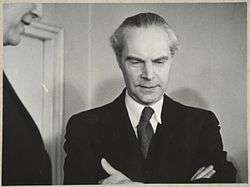Eino Kaila

Eino Sakari Kaila (August 9, 1890 – July 31, 1958[1]) was a Finnish philosopher, critic and teacher. He worked in numerous fields including psychology (sometimes considered to be the founder of Finnish psychology), physics and theater, and attempted to find unifying principles behind various branches of human and natural sciences.
Life
Eino Kaila was born in Alajärvi, Finland. Kaila's father, Erkki Kaila was a Protestant minister and later archbishop. He graduated from the University of Helsinki in 1910. In the 1920s he worked in the field of literary criticism and psychology as a professor at the University of Turku and is said to have been the first to introduce gestalt psychology to Finland. He was a part of the cultural circles of the time with the likes of Jean Sibelius and Frans Eemil Sillanpää and in 1919 he married the painter Anna Lovisa Snellman. In 1930 he was appointed professor of philosophy at the University of Helsinki. Kaila first visited Vienna in 1929 and took part in the sessions of the Vienna Circle. During World War II Kaila lectured in Germany. In 1948 Kaila became a member of the Finnish Academy. He died in Kirkkonummi on August 1, 1958.
Ideas
Despite being greatly influenced by the logical positivists and critical of unempirical speculation, an aspect common to all of Kaila's work was in strive for a holistic, almost pantheistic understanding of things. He also maintained a more naturalist approach to psychology. His book Persoonallisuus (1934, Personality) was a psychological study with philosophical dimensions, in which emphasized the biological nature of psychological phenomena. During the last years of his life he attempted to construct a theory of everything in Terminalkausalität Als Die Grundlage Eines Unitarischen Naturbegriffs, but this, what was meant to be the first installment in a more extensive study, was not met with much enthusiasm outside of Finland.
Though he withdrew his support of the National Socialists before the end of the Second World War, he wrote about the differences between "western" and "eastern" thought and claimed that the homogeneity of the people was a necessity for a functioning democracy.
Influence
Kaila's most famous pupil was Georg Henrik von Wright, who was the successor of Ludwig Wittgenstein at the University of Cambridge. The tradition of highly German-influenced analytical-idealist philosophy which Kaila championed remained unchallenged in Finnish philosophy until the appearance of continental influences in the 1980s. Kaila also founded the psychological laboratory at the University of Helsinki.
Notable works
- Der Logistische Neupositivismus, 1930
- Persoonallisuus (Personality), 1934
- Inhimillinen tieto (Human Knowledge), 1939
- Terminalkausalität Als Die Grundlage Eines Unitarischen Naturbegriffs, 1956
References
- Petri Liukkonen. "Eino Kaila". Books and Writers (kirjasto.sci.fi). Archived from the original on 4 July 2013.
- Humanistit tieteilevät (in Finnish)
- Eino Kaila ja tie Wienin piiriin (in Finnish)
External links
- Works by or about Eino Kaila at Internet Archive
- Works by Eino Kaila at Project Gutenberg
- Eino Kaila in 375 humanists 09.02.2015, Faculty of Arts, University of Helsinki